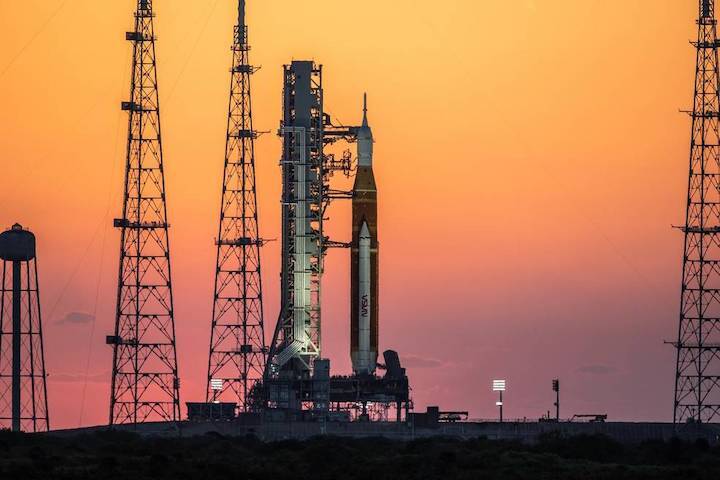28.03.2025
Terminated grants include efforts to get students and underrepresented groups involved in science

Just before midnight on Friday, 21 March, the Department of Government Efficiency (DOGE) announced in a post on X that NASA had terminated $420 million in “unneeded contracts.” Just what had been eliminated was unclear. But since then, scientists and space policy experts have found evidence for tens of millions of dollars worth of possible cuts, including within programs focused on science, technology, engineering, and math (STEM) outreach and diversity efforts.
“It’s work that’s not going to get done, it’s bills that aren’t going to get paid, it’s students that aren’t going to get trained,” says Sarah Hörst, a planetary scientist at Johns Hopkins University whose Bluesky post about the terminations on 24 March first tipped many scientists off to the cuts, despite DOGE’s cryptic post on Friday.
With NASA, it may be tempting to “think that we take all this money and we launch it into space,” she adds, “but it’s spent here on the ground in everybody’s communities."
The absence of clear DOGE records and communication from NASA on the terminated grants and contracts has left many affected researchers in the dark. Hörst first learned of the terminations from her best friend from graduate school, Oklahoma State University (OSU) planetary scientist Kat Gardner-Vandy, whose grant for a NASA partnership called Native Earth | Native Sky had been canceled on 21 March.
That project, launched in 2021 as part of a NASA program to connect people of all ages and backgrounds with science, had already created culturally relevant STEM curricula for 5000 middle schoolers in the Cherokee, Choctaw, and Chickasaw nations. Cancellation of the program—which had received $3 million in funding and was set to receive a final $972,000—“came as a shock,” Gardner-Vandy tells Science. She adds that OSU is looking into next steps, including appealing.
Friday’s terminations also included a grant to the National Society of Black Physicists (NSBP), a nonprofit professional organization with more than 600 members. In 2024, NSBP received a NASA grant worth up to $774,000 to sponsor NSBP’s annual conferences in 2024, 2025, and 2026, which the group hosts jointly with the National Society of Hispanic Physicists. According to Stephen Roberson, NSBP’s president, the termination will cut at least $200,000 in funding for the 2026 conference, which he says will jeopardize support for student travel to an event that inspires future physicists.
“When you see hundreds and hundreds and hundreds of African American, Hispanic American, [and] international people all coming together to talk about physics, it makes you think, ‘You know, this is
something that I could do for my career,’” Roberson says. “To have fewer students experience that, especially because of a drop in government funding through no fault of our own, is disheartening.” NSBP is planning to appeal NASA’s decision.
Many other NASA-supported researchers are unsure whether their project has survived. A project director for a nearly 30-year-old NASA Earth observation program found out that her branch of the program might have been defunded only after Science told her it had identified the program in government data sets and asked for comment. “We’ve continued working because we had no idea that we were terminated,” says the project director, who asked to remain anonymous for fear of retaliation. “Now [employees] can’t invoice for work that they’ve done because I have no way of paying.” She has not been able to confirm the fate of her program.
Casey Dreier has tried to clarify matters. After trawling various government data sets, Dreier—chief of space policy at the Planetary Society—posted a spreadsheet of potentially terminated grants to Bluesky on 25 March.
The informal spreadsheet, tracking more than 60 grants as of 27 March including the ones to Gardner-Vandy, NSBP, and the Earth observation project, has served as the de facto account of the NASA cuts. However, its totals amount to $48 million in terminated grant awards, $26 million of which has already been paid out to recipients—far short of the hundreds of millions of dollars’ worth of cuts claimed by DOGE.
Dreier plans to keep tracking NASA grant terminations as more information trickles out. “It’s one thing to wave your hand and say, ‘We saved all this money,’” he says. “But it’s another to say, ‘Here’s what we are not doing with it as a consequence.’”
The 21 March NASA cuts add to what may be the space agency’s largest grant termination so far: the funding for NASA’s Socioeconomic Data and Applications Center (SEDAC). That loss was part of the $400 million worth of funding cuts imposed on Columbia University, SEDAC’s host, earlier this month because of its alleged failure to stem antisemitism on campus.
Since the 1990s, SEDAC has made NASA satellite data usable for stakeholders. Perhaps its best known data set is the Gridded Population of the World, which takes point-based census data for where people live worldwide and adapts it to a global grid of 1-kilometer resolution, useful for assessing disaster impacts and other risks to human populations. Losing the 5-year, $30 million grant that funded SEDAC is “cutting at the knees some of the capabilities that NASA has painstakingly cultivated,” says Alexander De Sherbinin, a geographer at Columbia who leads SEDAC. “I’m just sorry it had to end like this.”
Multiple scientists who depend on NASA now worry their projects may be next on the chopping block or won’t get funded at all. They include Hörst herself, who has a pending NASA collaboration to get college students involved in space. “It feels really lonely to be a scientist right now,” she says.
Quelle: AAAS
